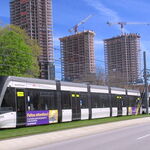Responding to the HSR potential aspect:
The most interesting thing about that article is the comment about possibly opening up VIA rail funding to allow the provinces to give money. It may allow VIA to operate the HSR.
"operate the HSR"?
Realistically: How about both?
Nothing stops GO HSR and VIA HSR from co-existing on the same route.
Heck, it may make certain parts of the route more cost-effective.
Maybe GO handles commuter HSR (London-Kitchener-Toronto), and VIA handles true intercity HSR (Toronto-Ottawa-Montreal). With VIA running some HSR trainsets along the whole route for the tourist market (VIA paying Metrolinx the privilege to use their own planned electricified tracks for HSR west of Toronto).
- The GO RER has plans to electricify to Kitchener, possibly within 10 years. This is part of the Kitchener HSR route, and Metrolinx owns this route. And Ontario may darn nearly fully funds this. In this case, a new subsidiary of Metrolinx would be a shoo-in to operate the first HSR heading west of Toronto.
- The HSR is more viable along the Windsor-London-Kitchener-Toronto leg, than the Toronto-Kingston-Ottawa-Montreal leg. This is because the cities essentially become within commuter distance of each other.
- In Japan, the shinkansen bullet trian daily commuters often commute 100-200km one-way daily; very similiar to distance between London-Kitchener-Toronto. Japanese often commute by HSR quicker than Torontoians commute by TTC bus.
- London-Kitchener-Toronto is commuter HSR territory
- Toronto-Ottawa-Montreal is non-commuter HSR territory
- See article
High-speed rail to Toronto for as low as $10?, yes said Queen's Park -- that's commuter ballpark -- and a strong hint of a subsidary of Metrolinx being a shoe-in as the HSR operator west of Toronto.
- Since Metrolinx will own the first 100km+ electricified train route, they could theoretically operate express trains at up to 250kph in some sections, Acela Express style
- Ontario HSR plans is a bit ahead of federal HSR plans at the moment. (delays aside)
From this detail, it would be silly not to consider the "commuter HSR" angle.
Based on current trends (and delays, delays, delays), I'd wager that a London-Kitchener-Toronto Metrolinx-operated would be GO HSR -- high-speed express commuter trains happening before VIA using Acela Express style trainsets for operation in by-then existing electricified GO RER corridor. GO RER HSR by the late 2030s (wild guess of timing) and VIA HSR sometime after.
Depending on what color Queens Park is, and the Feds, it could be conceivable VIA is the only operator of HSR trains. But realistically, eventually both Metrolinx and VIA will operate HSR trains for different markets (e.g. commuters) along segments of the same HSR line. Either way, VIA needs to keep improving. It's nice to finally be able to go to Ottawa in less than 4 hours, thanks to the Kitchener ROW renovation. Keep shaving half hours off, and get the VIA train to Ottawa in less than 3 hours from Toronto using existing diesel trainsets, then less than 2 hours from Toronto after electricification. But it looks like Metrolinx might end up beating VIA to having a HSR, at least the Kitchener-Toronto leg.
If you're gambling with a bet -- "Who runs the first electricified HSR service in Canada?" -- then I am tempted -- very tempted to put it on that green-colored provincial agency that begins with a "M" and ends with an "X".
But I'd love to be sitting on a VIA HSR to Ottawa, my hometown -- if the cost can be justified. (I wouldn't protest if shovels hit the ground!)






